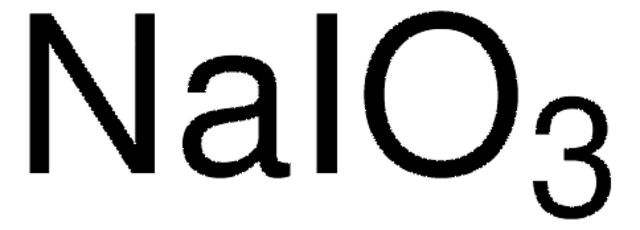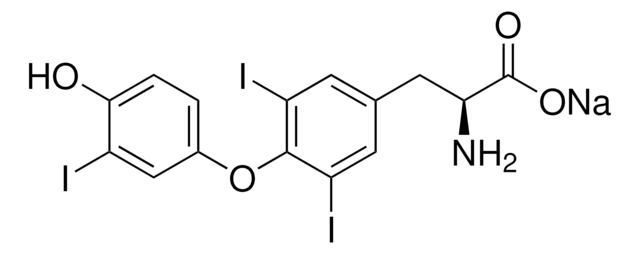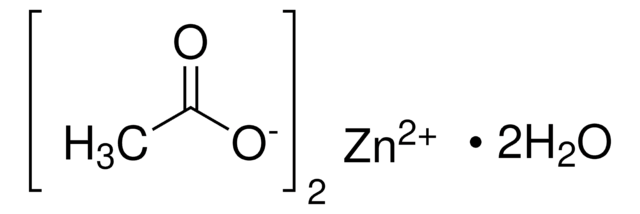推荐产品
等級
reagent grade
化驗
≥98%
形狀
powder
mp
560 °C (lit.)
密度
3.93 g/mL at 25 °C (lit.)
SMILES 字串
[K+].[O-]I(=O)=O
InChI
1S/HIO3.K/c2-1(3)4;/h(H,2,3,4);/q;+1/p-1
InChI 密鑰
JLKDVMWYMMLWTI-UHFFFAOYSA-M
正在寻找类似产品? 访问 产品对比指南
一般說明
KIO3 can be used as a substitute of KI in radiation protection. A kinetic study of thermal degradation of KIO3 by γ-rays suggests that rate of decomposition increases while activation energy decreases upon irradiation.
應用
Potassium iodate (KIO3) may be used as an oxidizing agent in the estimation of hydrolyzable tannins (gallotannins and ellagitannins) in plant samples. It may also be used in the preparation of polyaniline, poly(o-anisidine), poly[aniline-co-(o-anisidine) and TiO2 nanoparticles.
訊號詞
Danger
危險聲明
危險分類
Acute Tox. 4 Oral - Eye Irrit. 2 - Ox. Sol. 2
儲存類別代碼
5.1B - Oxidizing hazardous materials
水污染物質分類(WGK)
WGK 1
閃點(°F)
does not flash
閃點(°C)
does not flash
其他客户在看
Mechanistic study of osmium (VIII) promoted oxidation of crotonic acid by aqueous alkaline solution of potassium iodate
Singh B, et al.
Indian Journal of Chemistry, 54, 1387-1393 (2015)
Thermal decomposition kinetics of potassium iodate.
Muraleedharan K.
Journal of Thermal Analysis and Calorimetry, 114(2), 491-496 (2013)
Synthesis and properties of polyaniline, poly (o-anisidine), and poly [aniline-co-(o-anisidine)] using potassium iodate oxidizing agent
Neetika M, et al.
High Performance Polymers (2016)
Yawen Wang et al.
Journal of colloid and interface science, 430, 31-39 (2014-07-07)
In this paper, we report a novel polyol process to synthesize highly water-dispersible anatase titanium dioxide (TiO2) nanoparticles (∼5 nm) by the introduction of inorganic oxidizing agent--KIO3. The obtained TiO2 nanoparticles are well dispersible in water at pH≥5.0 and the
Paul W Hartzfeld et al.
Journal of agricultural and food chemistry, 50(7), 1785-1790 (2002-03-21)
A widely used method for analyzing hydrolyzable tannins afer reaction with KIO(3) has been modified to include a methanolysis step followed by oxidation with KIO(3). In the new method, hydrolyzable tannins (gallotannins and ellagitannins) are reacted at 85 degrees C
我们的科学家团队拥有各种研究领域经验,包括生命科学、材料科学、化学合成、色谱、分析及许多其他领域.
联系客户支持










